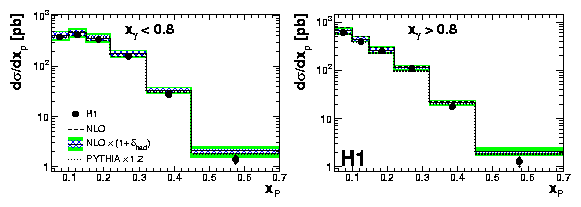 Compared to the
previous H1 publication, this paper presents new measurements with increased statistical
precision and an improved understanding of systematic uncertainties.
The cross sections for dijet production are measured as a function of the
transverse energy of leading jet (Et,max), the momentum fractions
of the photon (xgamma) and the proton (xp)
participating in the hard interaction, and the angle of the dijets in
their centre-of-mass system- cos(theta*).
Compared to the
previous H1 publication, this paper presents new measurements with increased statistical
precision and an improved understanding of systematic uncertainties.
The cross sections for dijet production are measured as a function of the
transverse energy of leading jet (Et,max), the momentum fractions
of the photon (xgamma) and the proton (xp)
participating in the hard interaction, and the angle of the dijets in
their centre-of-mass system- cos(theta*).
In order to test the theory as closely as possible, measurements are presented separately for events originating from predominantly direct photon (xgamma>0.8) or resolved photon (xgamma<0.8) processes. The region of xgamma>0.8, in which the photon predominantly interacts directly with the proton, is particularly well suited to test the proton structure as the photon structure plays no significant role there. The data in the region of xgamma<0.8, where the photon behaves like a hadronic object, may also provide additional constrains on the photon parton density function.
In addition the cross sections are investigated at different jet topologies: the case where both jets are in the "backward" direction, where both jets are in the "forward" direction, and where on jet is in the "forward" and one in the "backward" direction.
The data compare well with predictions from Monte Carlo event generators based on leading order (LO) QCD and parton showers and with next-to-leading order (NLO) QCD calculations, except for large xp where there is large uncertainty from the proton parton density function. This uncertainty can be largely reduced using this photoproduction dijet measurement in the global QCD fit analysis.